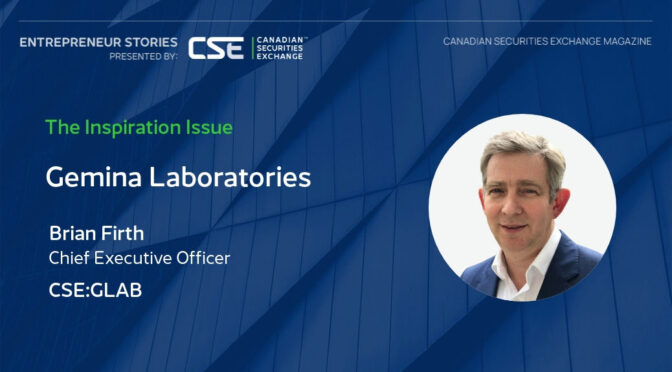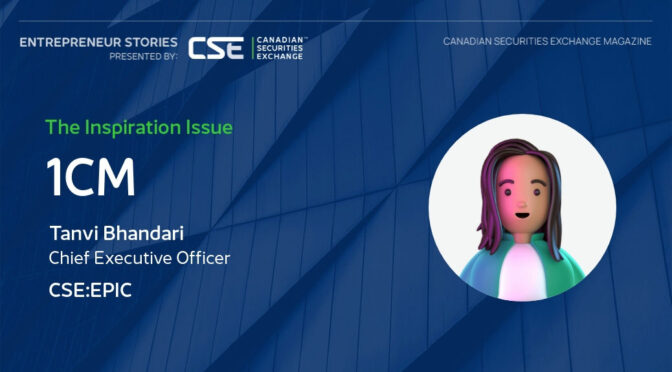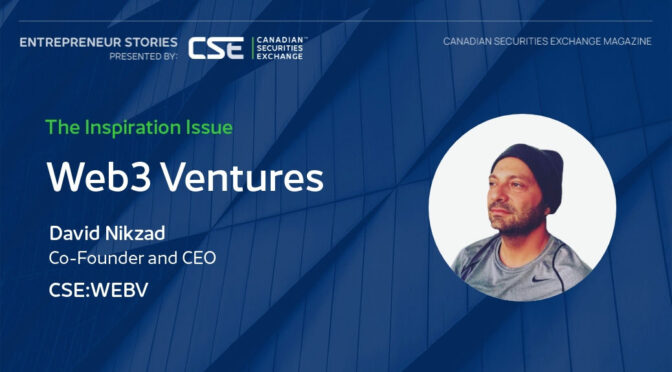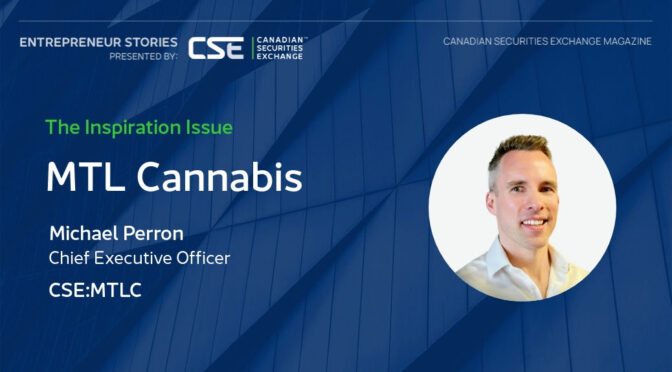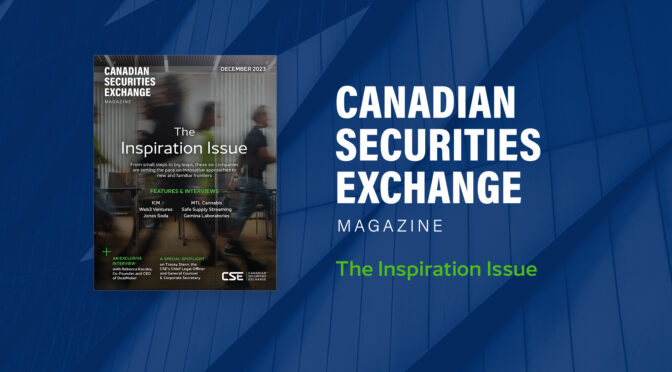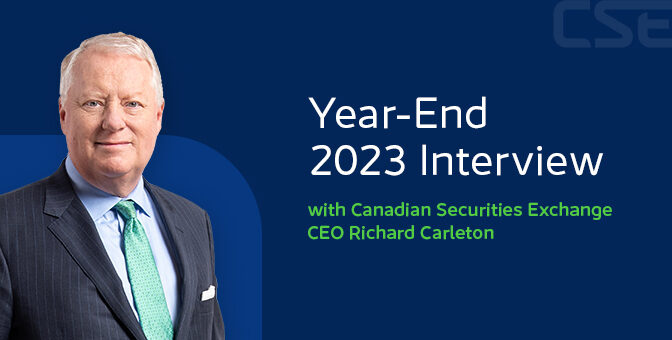Throughout December, we’re looking back on the year and sharing our favourite highlights from each month. To kick things off, we’re rewinding to January, when we attended a renowned mining event and published a special edition of Canadian Securities Exchange Magazine.
January Highlights
Vancouver Resource Investment Conference (VRIC)
On January 29–30, the Vancouver Resource Investment Conference (VRIC), produced by Cambridge House International, made its highly-anticipated return.
In the lead up to the conference, we had the honour of speaking with Jay Martin, President and CEO of Cambridge House, on a special episode of The Exchange for Entrepreneurs Podcast. Jay Martin spoke with us about the importance of reviving VRIC as an in-person event, his investor newsletter, and engaging with capital markets discourse from all sides.
You can watch the episode here.
Following this insightful discussion, we were eager to connect with and learn from the many thought leaders, companies, investors, peers, friends, and colleagues in the mining space who attended this renowned conference.
Several CSE-listed issuers also exhibited at the event, including:
To close out VRIC, we held our Cross-Border Networking Reception, in collaboration with our event partners, OTC Markets, Odyssey Trust, MNP, Investing News Network, DealMaker, Grove Corporate Services, and Bennett Jones.
It was great to connect with friends old and new and to gain fresh industry insights. We hope to see everyone again at VRIC 2024!
View the album: Cross-Border Networking Reception
Canadian Securities Exchange Magazine: The Mining Issue (VRIC Edition)
In preparation for VRIC, we published and distributed a special edition of the 2023 Mining Issue of Canadian Securities Exchange Magazine.
This issue, which offered a preview of the full edition published in March, highlights the stories of six companies boldly leaning into world-class opportunities within the context of rising interest in gold and battery metals.
Companies featured in this edition include:
- Irving Resources (CSE:IRV)
- Li-FT Power
- Relevant Gold
- Snowline Gold
- Tantalex Lithium Resources (CSE:TTX)
- Western Uranium & Vanadium (CSE:WUC)
Read now: Canadian Securities Exchange Magazine: The Mining Issue (VRIC Edition)
February Highlights
Ray Williams on The Exchange for Entrepreneurs Podcast
In honour of Black History Month, we had the pleasure of speaking with Ray Williams, Vice Chairman and Managing Director of Financial Markets at National Bank Financial, on the Exchange for Entrepreneurs Podcast.
This special episode delivers a fascinating look at the importance and limitations of Black History Month, the opportunities and benefits of furthering diversity on both a human and economic level, and the legacy of 100 Strong and Black Opportunity Fund, which both champion Black individuals to succeed in Canada.
Notably, this discussion provides a prompt for executives and investors alike to ask themselves the question of whether they’re doing enough to investigate, encourage, and mentor talent from all backgrounds and to best position their firms for the greatest success.
Watch now: Ray Williams on “Capitalizing” on Diversity | The CSE Podcast Ep7-S3
PreDAC Vancouver & Toronto
Leading up to the renowned PDAC Convention, organized by Prospectors & Developers Association of Canada, we teamed up with Investor.Events to host PreDAC Vancouver and PreDAC Toronto.
Our highly-anticipated mining industry networking events were a great success, with the Toronto session knocking attendance out of the park as a sold-out event.
We enjoyed connecting with friends old and new for two exciting afternoons filled with pitches, industry insights, presentations, networking, and great company.
Enjoy reminiscing with these photo highlight albums from each event!
View the albums: PreDAC Vancouver 2023 & PreDAC Toronto 2023
March Highlights
PDAC Convention & PDAC Investor Luncheon
Organized by the Prospectors & Developers Association of Canada, the PDAC Convention has been the world’s premier mineral exploration and mining convention for over 90 years. With our strong connection to the mining industry, the CSE was proud to attend, exhibit, and be a media partner at this world-renowned event.
Throughout this four-day event, there was a high volume of activity, including fascinating programming, exhibits, and extensive networking opportunities with leaders in the mineral exploration and mining sectors. Along with connecting with attendees at our booth on the exhibition floor, we produced and provided mining-focused content, and distributed free copies of the mining edition of our magazine.
It was a thrill to connect with CSE-listed mining companies and to host our Investor Luncheon, which featured a keynote address from Mr. Peter Kent, former Minister of Environment and Climate Change of Canada, former Member of Parliament, and current ; rapid-fire pitch presentations; and was sponsored by MNP, DSA Corporate Services, Marrelli Support Services, Investor.Events, BTV, INN, Market One, Newsfile, Purves Redmond, W.D. Latimer, Vested, and SmallCap Communications.
We’re looking forward to next year’s convention!
View the album: PDAC Investor Luncheon
Canadian Securities Exchange Magazine: The Mining Issue
Expanding on the VRIC edition, we launched the full version of the 2023 Mining Issue of Canadian Securities Exchange Magazine, in conjunction with PDAC.
This edition offers insight into mining companies that are reaching far corners of the globe, from Japan to the Democratic Republic of the Congo, in light of rising interest in gold and battery metals, including:
- Irving Resources (CSE:IRV)
- Li-FT Power
- Relevant Gold
- Snowline Gold
- Tantalex Lithium Resources (CSE:TTX)
- Western Uranium & Vanadium (CSE:WUC).
In addition to featuring these fascinating stories and perspectives, the full edition spotlights the CSE’s Anna Serin, Director of Listings Development Western Canada and US and Vancouver Branch Lead, who shares her family connection to the mining space.
Read now: Canadian Securities Exchange Magazine: The Mining Issue
April Highlights
Senior Tier Launch
This April, we were proud to announce a major policy update at the Exchange, which included the launch of our long-awaited Senior Tier.
The CSE received final approval from the Ontario Securities Commission and British Columbia Securities Commission to materially revise its listing policies. These amendments create a level playing field with other exchanges, ushering in a new era at the CSE.
With a strengthened competitive environment for issuers, enhanced investor confidence, and greater accessibility to a broader range of institutional investors, this was a defining moment for issuers, investors, and the CSE team.
Read Now: Updated Policies for Canadian Securities Exchange Usher in New Era for Exchange and its Stakeholders
Growing Steady
We were proud to announce record growth numbers in our March market statistics, released on April 18, 2023. Not only did we see 30 new corporate listings in the first quarter of the year, but we also saw eight IPOs, proving the CSE remains the IPO destination of choice for emerging corporate issuers.
These growth numbers were a fantastic milestone to cap off the start of 2023 and set the pace for the months ahead.
Read now: Canadian Securities Exchange Reports March 2023 Performance Figures
May Highlights
Welcoming New Members to the CSE Team
Change has certainly been a central theme at the CSE this year. At the start of 2023, we had the pleasure of welcoming two new members to our management team: Tracey Stern and Stuart Schady.
Tracey Stern, Chief Legal Officer, General Counsel and Corporate Secretary, has had an extensive career as a senior market regulator with the Ontario Securities Commission and as a chief compliance officer with a Canadian investment dealer. In her new role, Tracey is supporting the continuing evolution of the CSE as a leading exchange for global entrepreneurial companies.
Stuart Schady, Vice President of Trading & Market Data Services, assumed his new role after three years at the CSE as Director of Business Development in the Trading & Market Data Services Group, with previous experience in various roles in global financial services. In his new role, Stuart is bringing his impressive focus on service and his knowledge of the ever-evolving trading landscape.
Read Now: Canadian Securities Exchange Announces Executive Appointments
In the spring, we were thrilled to welcome Melissa Robertson, who joined as our Listings Development, Events & Content Manager, and Dimitri Giller, our new Director of Listed Company Services, to the CSE team.
With his experience and knowledge in the tech space, Dimitri was featured in the 2023 Technology Issue of Canadian Securities Exchange Magazine, which would be released in June. In this interview, he shares his journey to the CSE and his thoughts on the challenges and opportunities tech companies are facing today.
Read now: Spotlight on Dimitri Giller
SME’s Current Trends in Mining: Richard Carleton Interview
Richard Carleton, CSE CEO, was interviewed at SME’s Current Trends in Mining Conference in New York City by Mark Bunting from Red Cloud TV.
During this fascinating interview, Richard discussed the CSE’s differentiators and successes in the mining sector, saying “We’ve been very successful in the mining space over the last 12 months. Roughly 80 companies or so have joined the Exchange from the mining sector.”
Richard also shared his uniquely positioned insights into trends in critical and precious metals, liquidity and OTC markets, and more.
Watch now: RCTV | Canadian Securities Exchange On-Site SME New York
June Highlights
Margin Eligibility Announcement
In June, we were proud to announce that, under the Canadian Investment Regulatory Organization’s margin eligibility rule, the CSE was identified as an “acceptable exchange.” This decision applied immediately to all CSE-listed securities.
Margin eligibility has ushered in significant benefits for CSE-listed securities, including enhanced liquidity and reduced financing costs, and has served to make the Exchange a more attractive home for potential issuers.
We are pleased to be able to meet the ever-evolving needs of companies listed with us.
Read Now: Canadian Securities Exchange Securities Eligible for Margin
Summit on Responsible Investment
On June 27, we hosted the first-ever Summit on Responsible Investment in Kelowna. Our socially responsible investing and environmental, social, and governance event brought together a considerable crowd of professionals from a diverse range of industries for a day packed with presentations, panel discussions, company spotlights, networking, and exhibiting.
The event was a resounding success, thanks in no small part to all of our guests, presenters, collaborators, and sponsors, MNP LLP, Dentons, Odyssey Trust, Socialsuite, Business Television (BTV), irlabs, Accelerate Okanagan, and Central Okanagan Economic Development Commission. Plus, attendees raised over $6,000 for the Central Okanagan Food Bank to help combat food insecurity in Kelowna and West Kelowna.
We are excited to bring the Summit back by popular demand in 2024. In the meantime, replays of each session are available free to watch on CSE TV.
Watch now: Summit on Responsible Investment Playlist
Canadian Securities Exchange Magazine: The Technology Issue
At the end of the month, we published the 2023 Technology Issue of Canadian Securities Exchange Magazine. With widespread advancements and numerous opportunities in technology, such as the public release of OpenAI’s ChatGPT and its rapid growth to 100 million users in just two months, this issue was exceptionally relevant for investors, entrepreneurs, and the over 100 CSE-listed companies in the technology space.
In this issue, we took a deep dive into the stories of six companies that are getting ahead of the curve with innovations to solve tomorrow’s problems today, from emergency communications to plant-derived nutraceuticals to cryptocurrency forensics.
The CSE-listed companies featured in this issue include:
Read now: Canadian Securities Exchange Magazine: The Technology Issue
July Highlights
Summer Networking
The CSE had an action-packed summer filled with great company, new connections, and incredible sightseeing.
We kicked off our summer event circuit by hosting our first-ever SunDAC mining networking event in June, co-hosted by Grove Corporate Services, Newsfile, and OCI Group, and sponsored by enPercept. It was a delight to have Zero Zero Pizza as our venue and to catch up with friends and contacts we reconnected with at this year’s PDAC Convention over delicious food and great drinks.
We also had a great time donning our cowboy hats and catching up with old and new friends in Calgary for our annual Stampede festivities, including pancake breakfasts, a CSE-hosted reception, and boot scootin’ parties.
Thank you to everyone who attended SunDAC and joined us on the Stampede grounds. We look forward to another summer of networking in 2024!
August Highlights
The CSE Open
In August, we hosted the 2023 CSE Open, which brought together friends and colleagues for a fun day of golf at the scenic Wooden Sticks Golf Club.
Along with being a great opportunity for networking, bonding, and working on our golf swings, we also supported two important causes: the Centennial Infant and Child Centre Foundation and Lions Foundation of Canada Dog Guides.
And what helped make the event a hole-in-one were our event sponsors: Independent Trading Group (ITG), MNP, and Dog and Pony Studios, as well as:
We look forward to playing another round next year!
View the album: The CSE Open 2023
Baseball Classic
We also had a great time taking our friends and clients out to the ball game at the 2023 CSE Summer Baseball Classic.
Vancouver’s Nat Bailey Stadium was the perfect setting for a summer baseball game, with the Vancouver Canadians and Hillsboro Hopps engaged in a thrilling showdown. It was wonderful connecting with colleagues and clients, and to show our appreciation for their enduring support.
Our sponsors irlabs, Odyssey Trust, SmallCap Communications, Capital Tides Vancouver Investor Cruise by Investor.Events, International Deal Gateway, and Stockhouse, helped make this event a home run.
Enjoy these photo highlights from this unforgettable day.
View the album: The CSE Summer Baseball Classic 2023
September Highlights
2023 Precious Metals Summit Beaver Creek
In September, the 2023 Precious Metals Summit Beaver Creek brought together professionals from the investment and mining spaces for panel discussions, presentations, and networking at a beautiful mountainside setting in Colorado.
We were proud to sponsor and attend this premier, invitation-only independent investment conference, and the CSE’s Richard Carleton, CEO; Anna Serin, Director of Listings Development for Western Canada and US & Vancouver Branch Lead; and Phillip Shum, Director of Listings Development had a great time connecting with friends and colleagues.
Several CSE-listed issuers were also in attendance at the event, including:
Plus, we had the pleasure of teaming up with MNP and MLT Aikins to host a daily social hour during the summit at the CSE Hospitality Suite. It was a fantastic way to network in between one-on-one meetings and other scheduled networking events while enjoying refreshments.
Thanks for having us!
View the photos: Beaver Creek 2023
Canadian Securities Exchange Magazine: The Precious Metals Issue
At the Precious Metals Summit Beaver Creek, we premiered the 2023 Precious Metals Issue of Canadian Securities Exchange Magazine.
This issue explores the definition of “precious” in today’s world, which seems to be taking on new meaning as energy-linked metals rise in prominence to feed the growing shift toward cleaner technology, and features the stories of precious and critical metals companies focused on bringing world-class jurisdictions to the limelight, from North America to West Africa.
CSE-listed companies featured in this issue include:
Rob Cook, the CSE’s Senior Vice President of Market Development, is also highlighted in this issue and shares his insights and trends in mining and the capital markets.
October Highlights
Family Office Showcase – London, England
We were thrilled to travel “across the pond” to sponsor a family office showcase in late September in London, hosted by Global Partnership Family Offices and presented by International Deal Gateway (IDG).
CSE-listed issuers, Discovery Lithium (CSE:DCLI), Hillcrest Energy Technologies (CSE:HEAT), and Gemina Laboratories (CSE:GLAB) also presented at the event.
Ahead of this exciting showcase, the CSE’s James Black sat down with Liz Priestman, CEO and Director of IDG, on The Exchange for Entrepreneurs Podcast.
The two discussed IDG’s role, family offices benefits and differentiators as investors, the focus on the UK, advice for CEOs, and IDG’s plans and success stories of companies they’ve worked with.
Watch now: Liz Priestman on Finding a Fit with Family Office Capital | The CSE Podcast Ep16-S3
International Mining and Resources Conference – Sydney, Australia
The CSE team journeyed to the land down under for the renowned International Mining and Resources Conference (IMARC) in Sydney, Australia.
At this renowned mining event, now in its 10th year, the CSE’s Richard Carleton, CEO, and Anna Serin, Director of Listings Development for Western Canada and US & Vancouver Branch Lead, had the chance to enjoy presentations covering the entire mining value chain and network with global mining leaders, resource experts, and leading companies.
It was great to be joined by CSE-listed companies, United Lithium (CSE:ULTH) and Inflection Resources (CSE:AUCU), and to celebrate United Lithium’s victory at the pitch competition!
During the conference, Richard Carleton was also given a moment in the spotlight in an interview with Kitco Mining. Richard discussed the current state of the mining sector, raising capital as a Canadian miner in Australia, and major economic trends.
Thanks for having us!
Read now: ‘Tremendous number of new projects’ in the critical minerals space: Canadian Securities Exchange CEO
November Highlights
Red Cloud Fall Mining Showcase 2023
We were proud to be an event sponsor for the Red Cloud Fall Mining Showcase, in partnership with PearTree, on November 7–8 at the Sheraton Centre Toronto Hotel in Toronto.
Thank you to everyone who joined us for this action-packed event. It was great to connect with colleagues and friends in the mining space and meet with attendees from around the world.
Plus, CSE-listed companies, ACME Lithium (CSE:ACME), CDN Maverick Capital (CSE:CDN), Kuya Silver (CSE:KUYA), and Latitude Uranium (CSE:LUR) were in attendance.
A special thank you to Red Cloud and PearTree for having us and for putting on such a great showcase. We’re looking forward to the next one!
MJBizCon
Thanks to everyone who joined us at MJBizCon, which took place at the exciting Las Vegas Convention Center in Las Vegas! It was great to participate in this action-packed event, explore the exhibition floor, and dive into the current state of the cannabis landscape.
Plus, CEO of the CSE, Richard Carleton alongside Anil Mall, Director of Listed Company Services, and Phillip Shum, Director of Listings Development for Toronto, had the opportunity to connect with innovators, executives, and entrepreneurs alongside issuers in the cannabis space.
Thanks for having us and inspiring us to “dare to grow”! We’re thrilled to share our photo highlights from this exciting event.

